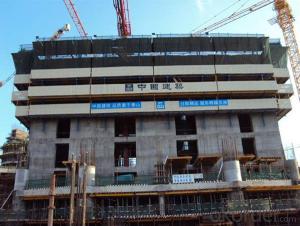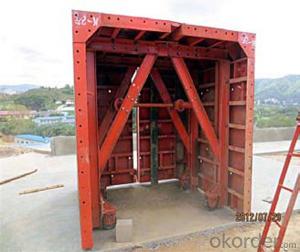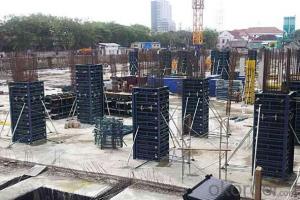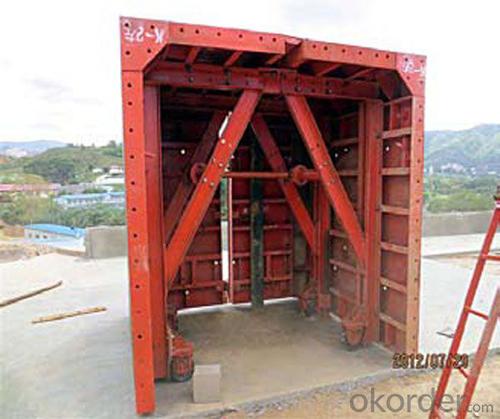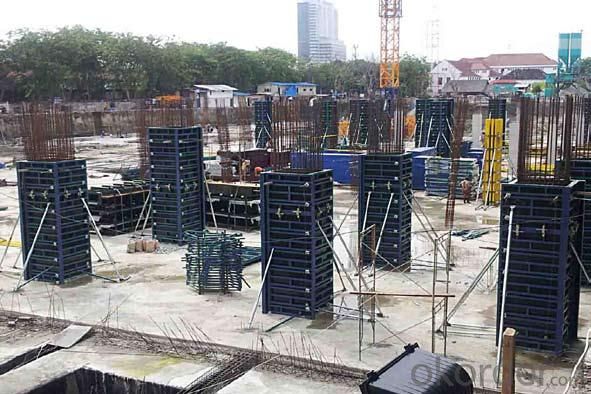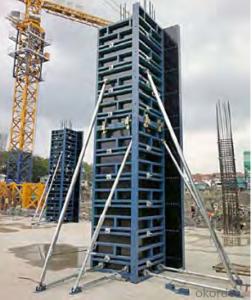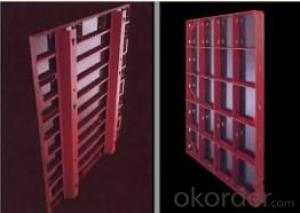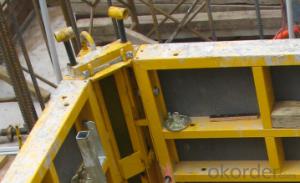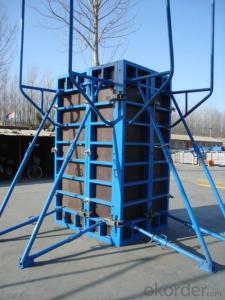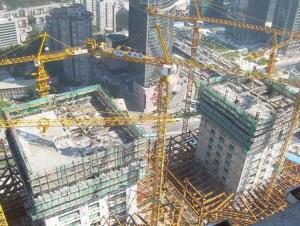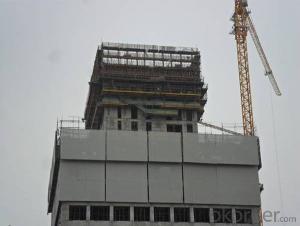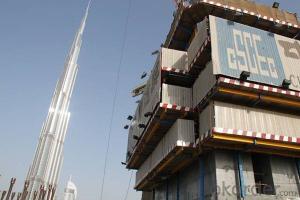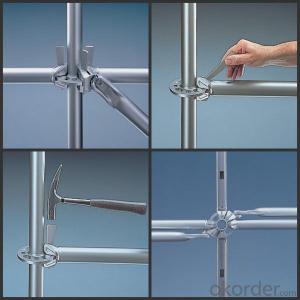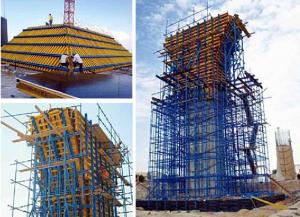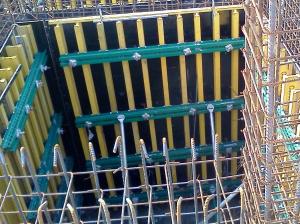Steel Formwork System Fromwork Accessories High Quality
- Loading Port:
- Tianjin
- Payment Terms:
- TT OR LC
- Min Order Qty:
- 25 m.t
- Supply Capability:
- 1000 m.t/month
OKorder Service Pledge
OKorder Financial Service
You Might Also Like
Steel Formwork System Fromwork Accessories High Quality
Product pictures:
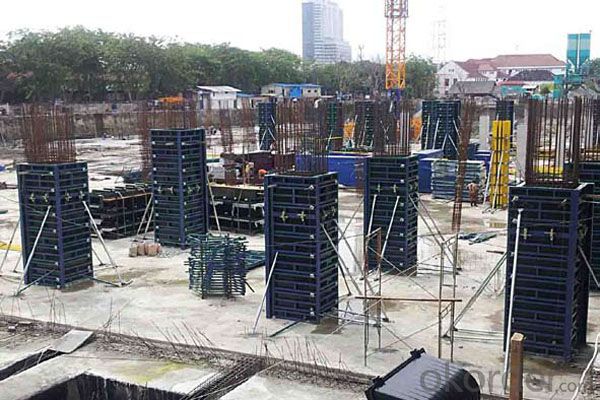
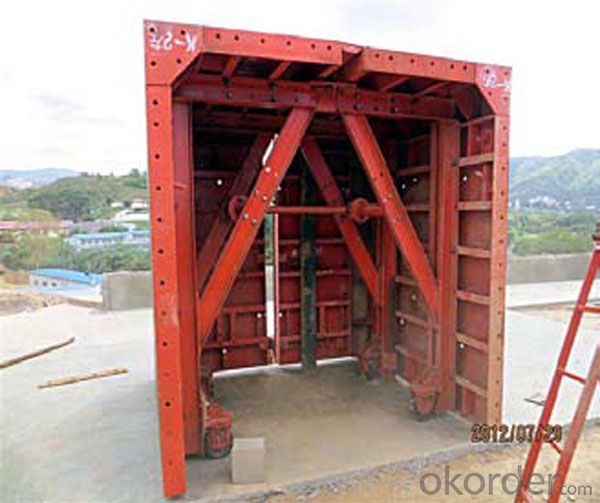
Product description:
Name: | RingLock Scaffold System |
Category: | Scaffolding System |
Material: | Steel (Q235/Q345) |
Size: | D48*3.25mm, etc |
Surface: | Electro Galvanized, Hot Dipped Galvanized, Painted, Powder Coated |
Component: | Standard, Ledger, Diagonal Brace, Bracket, Base Jack, U Head Jack, Etc. |
Application: | Slab Support, Staircase, Stage Plateforms, Bridge Support, Mobile Tower, etc. |
Manufacturer: | OEM is Available |
Items or goods can be manufactured according to your standards. | |
Advantage
* Good loading capacity
* Easy to assemble and dismantle
* Excellent quality for formwork & scaffolding with wide choices
Other scaffolding & formwork products:
(1) Scaffolding System:
(2) Scaffolding Frame & Accessories:
(3) Scaffolding Couplers/Clamps:
(4) Formwork System Scaffolding & Accessories:
Company introduce and advantages:
1. A state-owned company, prestige fi rst.
2. One of Fortune 500 companies in the world. No. 5 in the building material fi eld.
3. Six Sigma strategy , which means no more than 3.4 defects existing among one million of error
possibilities.
4. In line with the business, we launched E-business platform Okorder.com.
5. We are highly recognized by our business partners and clients all over the world and has obtained rapid
development under the spirit of win-win.
FAQ
Why Us?
We are one of the largest construction materials suppliers in China.
We own professional manufacturers with powerful producing capacity.
Extensive and comprehensive quality control system
Excellent products with competitive prices.
Efficient services in pre and after sale.
Full energy with affluent experience team.
- Q: What are the key quality control measures for steel frame formwork installation?
- To ensure the structural integrity and safety of the formwork system, it is crucial to follow several key quality control measures for steel frame formwork installation. These measures are as follows: 1. Thoroughly inspect the steel frame formwork before commencing installation. This involves checking for damages, defects, or missing components. Address and resolve any issues before proceeding. 2. Ensure accurate alignment of the steel frame formwork to achieve a seamless fit and stable structure. Check the vertical and horizontal alignment, as well as the levelness and plumbness of the components. 3. Secure the connections between the steel frame formwork components tightly and securely. Use appropriate fasteners such as bolts or screws, and ensure they are properly tightened to avoid instability. 4. Level and flatten the surfaces of the steel frame formwork to provide a stable and uniform support for the concrete. Use leveling tools like spirit levels or laser levels to align and adjust the formwork. 5. Properly place and secure reinforcement bars if required in the formwork system. Ensure correct positioning and adequate support to prevent displacement during concrete pouring. 6. Adequately brace the steel frame formwork to prevent deformation or collapse. Use diagonal braces or stiffeners and ensure all bracing components are properly secured and tightened. 7. Conduct regular inspections and maintenance throughout the installation process to identify potential issues or defects. Repair or replace any damages or defects immediately to ensure safety and effectiveness. By adhering to these key quality control measures, the steel frame formwork installation can be carried out efficiently and effectively, resulting in a robust and reliable structure for concrete casting.
- Q: What are the different types of formwork systems that can be used in conjunction with steel frame formwork?
- There are several different types of formwork systems that can be used in conjunction with steel frame formwork. These include: 1. Timber formwork: Timber formwork is one of the most commonly used formwork systems. It involves using timber boards or plywood to create the formwork structure. Timber formwork is versatile, cost-effective, and easy to work with. It is suitable for a wide range of concrete structures, including walls, columns, beams, and slabs. 2. Aluminum formwork: Aluminum formwork is a lightweight and durable formwork system. It consists of aluminum panels that are connected together to create the formwork structure. Aluminum formwork is known for its high strength-to-weight ratio, which allows for faster construction and reduced labor costs. It is commonly used for repetitive structures like residential buildings and commercial complexes. 3. Plastic formwork: Plastic formwork is a relatively newer formwork system that is gaining popularity due to its versatility and ease of use. It is made of lightweight and durable plastic panels that can be easily assembled and disassembled. Plastic formwork is suitable for a wide range of concrete structures, including walls, columns, and slabs. It offers advantages such as lower labor costs, reduced formwork waste, and improved construction speed. 4. Fiberglass formwork: Fiberglass formwork is a lightweight and high-strength formwork system. It is made of fiberglass panels that are capable of withstanding high concrete pressures. Fiberglass formwork is suitable for a variety of concrete structures, including walls, columns, beams, and slabs. It offers advantages such as easy handling, reduced labor costs, and improved construction speed. 5. Modular formwork: Modular formwork refers to a system where standardized formwork components are used to create various formwork configurations. It can be used in conjunction with steel frame formwork by integrating the steel frames with the modular formwork components. Modular formwork is highly flexible and can be adjusted to suit different construction requirements. It is suitable for complex structures and can be easily reused, making it a cost-effective option. Overall, these different types of formwork systems offer a range of advantages, such as versatility, cost-effectiveness, ease of use, and increased construction speed. The choice of formwork system will depend on factors such as the construction project's requirements, budget, and timeline.
- Q: Are there any limitations or restrictions on the size or height of concrete structures that can be built using steel frame formwork?
- Yes, there are limitations and restrictions on the size and height of concrete structures that can be built using steel frame formwork. One limitation is the maximum height that can be achieved without additional support or reinforcement. Steel frame formwork is designed to withstand certain loads and pressures, and exceeding these limits can compromise the structural integrity of the formwork system. Therefore, there is a practical height limit imposed by the manufacturer or engineer that should be followed to ensure safety and stability. Additionally, the size of the concrete structure can also be limited by the availability and dimensions of the steel frame formwork panels. These panels come in standard sizes and configurations, and larger or irregularly shaped structures may require custom-made formwork or a different construction method altogether. Another factor that can impact the size and height of concrete structures is the weight and pressure exerted by the concrete itself. As the height or size of the structure increases, the pressure and weight of the concrete also increase. This can necessitate additional reinforcement or support systems, such as tie rods, braces, or scaffolding, to ensure the stability of the formwork and the safety of workers. Lastly, local building codes and regulations may impose specific limitations or restrictions on the size or height of concrete structures. These codes are in place to ensure the safety and stability of the structures, as well as to address any potential risks or hazards that may arise from larger or taller buildings. Therefore, while steel frame formwork provides a versatile and efficient solution for constructing concrete structures, there are limitations and restrictions that need to be considered to ensure the safety and feasibility of the project. It is essential to consult with engineers, architects, and construction professionals to determine the maximum allowable size and height of a concrete structure using steel frame formwork.
- Q: How does steel frame formwork ensure proper concrete compaction and consolidation?
- Steel frame formwork ensures proper concrete compaction and consolidation by providing a rigid structure that securely holds the concrete in place. The steel frame acts as a mold, supporting the weight of the concrete while it sets and hardens. This prevents any movement or deformation of the concrete during the pouring process, allowing for even compaction and consolidation. Additionally, the steel formwork can be designed with intricate patterns or shapes, which creates pressure on the concrete, further aiding in its compaction.
- Q: How does steel frame formwork affect the overall durability of a concrete structure?
- The overall durability of a concrete structure can be significantly improved by using steel frame formwork. There are numerous advantages that come with using steel as a formwork material, which contribute to the long-lasting nature of the concrete construction. To begin with, steel frame formwork offers outstanding strength and rigidity. This allows it to withstand high pressure and heavy loads during the pouring and curing process of the concrete. As a result, the risk of deformation or collapse during the construction phase is eliminated, ensuring the structural integrity of the concrete structure. Furthermore, steel is highly resistant to corrosion, which is a crucial factor in enhancing the durability of the concrete structure. Unlike other formwork materials like wood or plywood, steel does not rot, warp, or deteriorate over time due to moisture or exposure to the elements. This resistance to corrosion ensures the long-term stability and strength of the concrete structure, even in harsh environmental conditions. In addition, steel frame formwork offers exceptional dimensional stability. This ensures that the concrete elements maintain their intended shape and dimensions over time, preventing any potential cracks or deformations from occurring in the structure. Consequently, the overall durability of the concrete construction is enhanced. Moreover, steel formwork allows for precise and accurate construction, resulting in minimal variations and imperfections in the finished concrete structure. This precision ensures that the structure is built according to the desired specifications, reducing the risk of future issues or structural failures. Finally, steel frame formwork is reusable, making it a sustainable and cost-effective choice for concrete construction. The ability to reuse the formwork reduces material waste and construction costs while still maintaining the durability and quality of the concrete structure. In conclusion, steel frame formwork plays a pivotal role in enhancing the overall durability of a concrete structure. Its strength, resistance to corrosion, dimensional stability, precision, and reusability all contribute to a long-lasting and robust construction that can withstand the test of time.
- Q: How does steel frame formwork handle different types of formwork sealing techniques?
- The steel frame formwork system is highly versatile and robust, capable of effectively implementing various formwork sealing techniques. Its strength and stability ensure that it can withstand the pressure exerted by the concrete during pouring and curing. When it comes to formwork sealing techniques, the steel frame formwork system offers numerous advantages. Firstly, it provides a rigid and tight structure that prevents any concrete leakage. This is especially crucial when using liquid or flowable concrete mixes. The steel frame guarantees the integrity of the formwork, leaving no gaps or spaces for the concrete to escape. Secondly, the steel frame formwork system allows for the utilization of different sealing materials and techniques. For instance, rubber gaskets or seals can be used to create a watertight seal between the formwork and the structure. These gaskets are typically situated along the joints and edges of the formwork to prevent water or concrete seepage. Furthermore, the steel frame formwork system can accommodate the use of waterstops, which are placed within the formwork joints to prevent water penetration. These waterstops are commonly made of rubber or PVC and are highly effective in preventing any water leakage. Additionally, the steel frame formwork system can also incorporate the use of tie rods and formwork ties to ensure a secure and tight seal. These components are employed to tightly hold the formwork panels together, preventing any movement or displacement during concrete pouring. This helps to maintain the integrity of the formwork, guaranteeing its ability to handle various sealing techniques. To recap, the steel frame formwork system is well-equipped to handle different formwork sealing techniques. Its strength and stability create a solid structure that can endure the pressure from the concrete. Moreover, the flexibility of the steel frame allows for the utilization of different sealing materials and techniques, resulting in a watertight and secure formwork system.
- Q: Are there any limitations on the size and shape of structures that can be constructed using steel frame formwork?
- Yes, there are limitations on the size and shape of structures that can be constructed using steel frame formwork. The size of the structure may be limited by the maximum dimensions of the steel frame panels. Additionally, complex and intricate shapes may pose challenges in terms of the formwork's ability to accommodate and support the desired design. However, with proper planning and engineering, steel frame formwork can still be used to construct a wide variety of structures, including buildings, bridges, and other concrete elements.
- Q: What are the different types of formwork wedges used with steel frame formwork?
- Steel frame formwork systems can utilize various types of formwork wedges to ensure proper alignment and support during the concrete pouring process. The following are some common examples: 1. Tapered Wedges: These wedges have a tapered shape, making insertion and removal easy. They are typically constructed from plastic or steel and serve to secure the formwork panels. 2. Adjustable Wedges: Designed with threads, these wedges allow for precise adjustments in height and alignment. They are commonly employed in situations that demand accurate leveling and alignment. 3. Base Wedges: These wedges are placed at the formwork base to provide stability and support. Typically larger in size, they are made from durable materials like steel or high-density plastic. 4. Corner Wedges: Corner wedges are specifically used to secure the corners of the formwork panels. Their purpose is to maintain stability and proper alignment, particularly in areas where the formwork changes direction. 5. Locking Wedges: These wedges are utilized to lock the formwork panels together, ensuring a tight and secure connection. Often used alongside other types of wedges, they offer additional support and stability. In summary, formwork wedges are crucial for the successful installation and operation of steel frame formwork systems. They play a vital role in preserving the structural integrity of the formwork and ensuring accurate and secure concrete pouring.
- Q: Can steel frame formwork be used in retrofitting and renovation projects?
- Retrofitting and renovation projects can utilize steel frame formwork effectively. This adaptable and sturdy system can be easily adjusted to meet various project needs, providing a stable structure capable of withstanding the pressures and loads associated with such work. Steel frame formwork holds several advantages for retrofitting and renovation projects. Firstly, its high level of customization allows for precise alterations to existing structures, accommodating new elements or design changes seamlessly. Moreover, steel frame formwork can be repeatedly used, making it a cost-effective solution for retrofitting and renovation projects. Its durability and resistance to wear and tear ensure it can endure the demands of a construction site and be employed on multiple projects, reducing the need for frequent replacements. Furthermore, steel frame formwork can be assembled and disassembled with ease, offering a time-efficient option for retrofitting and renovation projects. This is particularly advantageous when working on tight schedules or in occupied buildings, as it minimizes disruption and enables quicker project completion. In conclusion, steel frame formwork proves to be an ideal choice for retrofitting and renovation projects. Its versatility, durability, and cost-effectiveness make it a suitable solution for adapting existing structures and accommodating design changes.
- Q: How does steel frame formwork help in achieving a smooth concrete finish?
- Achieving a smooth concrete finish is made possible with the use of steel frame formwork. This formwork system provides a sturdy and stable structure for pouring the concrete, preventing any sagging or bulging. It ensures that the concrete retains its desired shape and surface finish. The formwork is constructed from top-notch steel, renowned for its strength and durability. This guarantees that it can withstand the pressure exerted by the wet concrete without bending or distorting. Consequently, the concrete sets evenly and smoothly, minimizing any imperfections or irregularities on the surface. Moreover, the steel frame formwork system allows for precise control over concrete placement and compaction. The formwork can be adjusted and aligned to the desired dimensions and angles, ensuring accurate pouring. This eliminates the need for excessive manual finishing or leveling, resulting in a smoother and more consistent finish. Furthermore, the steel frame formwork also minimizes the risk of formwork marks or imprints on the concrete surface. The steel panels used in the formwork are smooth and non-porous, reducing the chances of any texture or pattern transferring onto the concrete. This ensures a clean and uniform appearance of the finished concrete. In conclusion, steel frame formwork is essential for achieving a smooth concrete finish. It provides stability, precision, and minimizes the risk of formwork marks. Its strength, durability, and versatility make it an ideal choice for ensuring high-quality finishes in concrete construction projects.
Send your message to us
Steel Formwork System Fromwork Accessories High Quality
- Loading Port:
- Tianjin
- Payment Terms:
- TT OR LC
- Min Order Qty:
- 25 m.t
- Supply Capability:
- 1000 m.t/month
OKorder Service Pledge
OKorder Financial Service
Similar products
Hot products
Hot Searches
Related keywords
